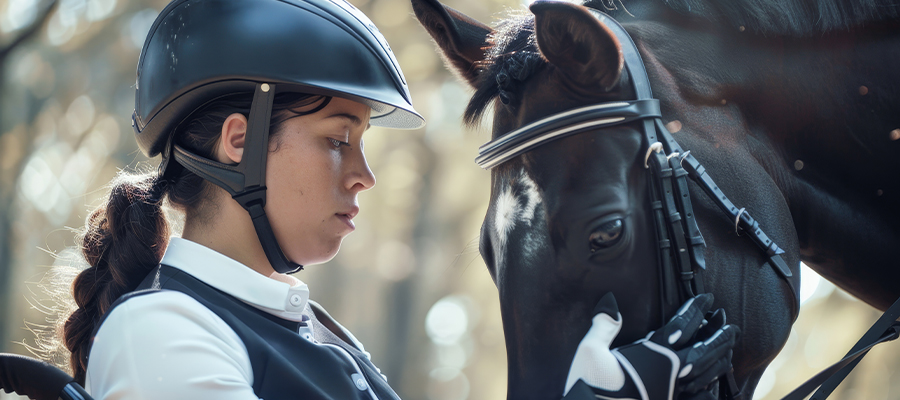Horse riding has long been recognized for its benefits in addressing physical and motor disabilities. However, its psychological impact remains relatively underexplored. Emerging evidence suggests that equine therapy — therapy involving horses can significantly enhance mental health through four key mechanisms: fostering feelings of accomplishment, building healthy relationships, reducing stress, and promoting mindfulness (Burgon et al., 2018; Siporin, 2012).
A Brief Historical Context
The roots of equine therapy trace back to ancient Greece, where Hippocrates acknowledged its healing potential. Sigmund Freud also incorporated animal-assisted therapy into his practice, using dogs (Hoagwood et al., 2017). Despite these early observations, systematic use of horses for therapeutic purposes only gained momentum during the 1960s, primarily targeting children with physical disabilities.
Horses, being highly intuitive prey animals, possess a remarkable sensitivity to human emotions and non-verbal cues, often more so than other animals like dogs and cats (Griffin, 2009; Karol, 2007). This natural sensitivity allows them to respond to human emotions almost instantaneously, making them ideal partners in therapy.
How Horse Riding Supports Mental Health
1. Fostering Feelings of Accomplishment
Mastering horse riding is inherently challenging. Riders must overcome fear, develop skill, and establish communication with a powerful animal. Successfully navigating these challenges builds self-confidence, patience, and self-esteem (Dingman, 2008; Gatty, as cited in Roberts, 1997).
Studies have shown that equine therapy enhances self-efficacy, especially in children with special needs and women recovering from dating violence (Froeschle, 2009; Roberts, 1997). Riding also improves body awareness and aids in rebuilding or redefining one’s identity (Wanneberg, 2014).
2. Building Healthy Relationships
The bond between horse and rider mirrors fundamental dynamics of human relationships. Horses are highly responsive to non-verbal communication such as posture and emotion (Brandt, 2004; Karol, 2007). Building trust with a horse requires empathy and clear communication, skills that translate directly into healthier human relationships (Siporin, 2012).
Equine-assisted therapy has proven beneficial for individuals with autism, PTSD, and attachment disorders, helping to improve social skills, trust, and emotional regulation (MacLean, 2011; Malcolm et al., 2018; Hoagwood et al., 2017). Activities like grooming and feeding the horse promote responsibility and care, while receiving non-judgmental feedback fosters emotional safety (Dingman, 2008).
3. Reducing Stress
Interacting with horses offers emotional support through unconditional positive regard, alleviating feelings of loneliness, depression, and stress (Dingman, 2008; Siporin, 2012). Riding allows individuals to assume the role of a rider rather than a patient, fostering a sense of agency and reducing anxiety (Hakansson, as cited in Wanneberg, 2014).
Evidence shows that horse riding increases self-actualization and decreases general psychological distress (Bivens et al., 2007; Earles et al., 2015). Equine therapy also facilitates emotional regulation and anger management (Barker & Dawson, 1998), helping individuals cope with stressors by promoting relaxation and cognitive reframing (Krohne, 2002).
4. Promoting Mindfulness
Horse riding demands continuous attention and present-moment awareness, enhancing mindfulness (Hoagwood et al., 2017; Kabat-Zinn, 2006). Losing focus can lead to loss of control over the horse, naturally training individuals to concentrate on the "here and now."
This mindful engagement benefits those with ADHD, autism, and anxiety disorders (Gabriel, as cited in Wanneberg, 2014). Horses also mirror human emotions, providing immediate feedback that raises self-awareness (Earles et al., 2015). Veterans with PTSD, for example, became more aware of their emotional states through interactions with horses (MacLean, 2011).
Mindfulness practices linked with emotional regulation are essential for treating anxiety and mood disorders (Rodrigues et al., 2017). Thus, horse riding serves not only to sharpen focus but also to regulate emotions and interrupt negative thought patterns.
Practical Applications and Considerations
Equine therapy shows promise for a wide range of psychological conditions, including trauma, inferiority complex, adjustment issues, PTSD, autism, ADHD, depression, loneliness, separation anxiety, and stress-related disorders.
However, limitations exist. Therapy involving horses requires considerable resources, specialized facilities, and trained professionals. Factors like fear of animals, costs, and risk of injury can deter some individuals from pursuing this therapy. Furthermore, more empirical research is needed to validate these findings and refine therapeutic models.
Future Directions
Future research can explore additional psychological benefits of horse riding and ways to simplify and expand access to equine therapy. Empirical validation of conceptual models like the one proposed here will strengthen the case for integrating horse-assisted interventions in mainstream mental health care.
Conclusion
Horse riding offers a unique psychotherapeutic approach by fostering accomplishment, strengthening relationships, reducing stress, and promoting mindfulness. Its potential in enhancing psychological well-being is vast, offering both clients and therapists a dynamic, experiential tool for healing.
References
- Barker, S. B., & Dawson, K. S. (1998). The effects of animal-assisted therapy on anxiety ratings of hospitalized psychiatric patients. Psychiatric Services, 49(6), 797–801. https://doi.org/10.1176/ps.49.6.797
- Bivens, A., Leinart, D., & Klontz, B. (2007). Equine-assisted psychotherapy for anxiety and posttraumatic stress symptoms. Journal of Traumatic Stress, 28(2), 149–152.
- Brandt, K. (2004). A language of their own: An interactionist approach to human–horse communication. Society and Animals, 12(4), 299–316.
- Burgon, H., Gammage, D., Hebden, D., & Jenny, H. (2018). Hoofbeats and heartbeats: Equine-assisted therapy and learning with young people with psychosocial issues—Theory and practice. Journal of Social Work Practice, 32(1), 3–16. https://doi.org/10.1080/02650533.2017.1300878
- Dingman, A. (2008). Hoof prints: Equine therapy for autistic children. Encounter: Education for Meaning and Social Justice, 21(4), 11–13.
- Earles, J. L., Vernon, L. L., & Yetz, J. P. (2015). Equine-assisted therapy for anxiety and posttraumatic stress symptoms. Journal of Traumatic Stress, 28(2), 149–152.
- Froeschle, J. (2009). Empowering abused women through equine-assisted career therapy. Journal of Creativity in Mental Health, 4(2), 180–190. https://doi.org/10.1080/15401380902945228
- Gabriel, R. (2015). Equine-assisted therapy and hyperactivity. International Journal of Therapy and Rehabilitation, 22(2), 57–62.
- Griffin, D. (2009). Animal minds: Beyond cognition to consciousness (2nd ed.). University of Chicago Press.
- Hoagwood, K. E., Acri, M., Morrissey, M., Pierce, M. P., & Robin, A. (2017). Animal-assisted therapies for youth with or at risk for mental health problems: A systematic review. Applied Developmental Science, 21(1), 1–13.
- Kabat-Zinn, J. (2006). Mindfulness-based interventions in context: Past, present, and future. Clinical Psychology: Science and Practice, 10(2), 144–156. https://doi.org/10.1093/clipsy/bpg016
- Karol, J. (2007). Applying a traditional individual psychotherapy model to equine-facilitated psychotherapy (EFP): Theory and method. Clinical Child Psychology and Psychiatry, 12(1), 77–90.
- Krohne, H. W. (2002). Stress and coping theories. In R. Fernández-Ballesteros (Ed.), Encyclopedia of psychological assessment (pp. 789–793). Sage.
- MacLean, B. (2011). Equine-assisted therapy. Journal of Rehabilitation Research and Development, 48(7), vii–ix. https://doi.org/10.1682/JRRD.2011.05.0085
- Malcolm, R., Ecks, S., Pickersgill, M., & Martyn, M. (2018). ‘It just opens up their world’: Autism, empathy, and the therapeutic effects of equine interactions. Anthropology & Medicine, 25(2), 220–234.
- Roberts, K. (1997). Equine-facilitated psychotherapy benefits children with disabilities. Journal of Rehabilitation, 63(3), 49–54.
- Rodrigues, M. F., Nardi, A. E., & Levitan, M. N. (2017). Mindfulness in mood and anxiety disorders: A review of the literature. Trends in Psychiatry and Psychotherapy, 39(3), 207–215. https://doi.org/10.1590/2237-6089-2016-0051
- Siporin, S. (2012). Talking horses: Equine psychotherapy and intersubjectivity. Psychodynamic Practice, 18(4), 457–464.
- Wanneberg, P. (2014). Disability, riding and identity: A qualitative study on the influence of riding on the identity construction of people with disabilities. International Journal of Disability, Development and Education, 61(1), 67–79. https://doi.org/10.1080/1034912X.2014.878546

